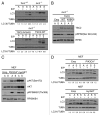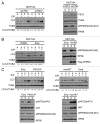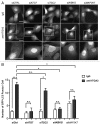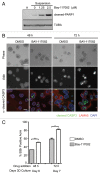IκB kinase complex (IKK) triggers detachment-induced autophagy in mammary epithelial cells independently of the PI3K-AKT-MTORC1 pathway
- PMID: 23778976
- PMCID: PMC3748193
- DOI: 10.4161/auto.24870
IκB kinase complex (IKK) triggers detachment-induced autophagy in mammary epithelial cells independently of the PI3K-AKT-MTORC1 pathway
Abstract
Adherent cells require proper integrin-mediated extracellular matrix (ECM) engagement for growth and survival; normal cells deprived of proper ECM contact undergo anoikis. At the same time, autophagy is induced as a survival pathway in both fibroblasts and epithelial cells upon ECM detachment. Here, we further define the intracellular signals that mediate detachment-induced autophagy and uncover an important role for the IκB kinase (IKK) complex in the induction of autophagy in mammary epithelial cells (MECs) deprived of ECM contact. Whereas the PI3K-AKT-MTORC1 pathway activation potently inhibits autophagy in ECM-detached fibroblasts, enforced activation of this pathway is not sufficient to suppress detachment-induced autophagy in MECs. Instead, inhibition of IKK, as well as its upstream regulator, MAP3K7/TAK1, significantly attenuates detachment-induced autophagy in MECs. Furthermore, function-blocking experiments corroborate that both IKK activation and autophagy induction result from decreased ITGA3-ITGB1 (α3β1 integrin) function. Finally, we demonstrate that pharmacological IKK inhibition enhances anoikis and accelerates luminal apoptosis during acinar morphogenesis in three-dimensional culture. Based on these results, we propose that the IKK complex functions as a key mediator of detachment-induced autophagy and anoikis resistance in epithelial cells.
Keywords: anoikis; autophagy; extracellular matrix; integrin; mammary epithelial cells.
Figures







Similar articles
-
Regulation of autophagy during ECM detachment is linked to a selective inhibition of mTORC1 by PERK.Oncogene. 2013 Oct 10;32(41):4932-40. doi: 10.1038/onc.2012.512. Epub 2012 Nov 19. Oncogene. 2013. PMID: 23160380 Free PMC article.
-
Induction of autophagy during extracellular matrix detachment promotes cell survival.Mol Biol Cell. 2008 Mar;19(3):797-806. doi: 10.1091/mbc.e07-10-1092. Epub 2007 Dec 19. Mol Biol Cell. 2008. PMID: 18094039 Free PMC article.
-
beta 1 integrin regulates fibroblast viability during collagen matrix contraction through a phosphatidylinositol 3-kinase/Akt/protein kinase B signaling pathway.J Biol Chem. 2002 Jul 5;277(27):24667-75. doi: 10.1074/jbc.M203565200. Epub 2002 May 1. J Biol Chem. 2002. PMID: 11986332
-
The Interconnections between Autophagy and Integrin-Mediated Cell Adhesion.J Mol Biol. 2017 Feb 17;429(4):515-530. doi: 10.1016/j.jmb.2016.11.027. Epub 2016 Dec 6. J Mol Biol. 2017. PMID: 27932295 Free PMC article. Review.
-
Extracellular matrix regulation of autophagy.Curr Opin Cell Biol. 2008 Oct;20(5):583-8. doi: 10.1016/j.ceb.2008.05.002. Epub 2008 Jun 21. Curr Opin Cell Biol. 2008. PMID: 18573652 Free PMC article. Review.
Cited by
-
Integrinβ-1 in disorders and cancers: molecular mechanisms and therapeutic targets.Cell Commun Signal. 2024 Jan 26;22(1):71. doi: 10.1186/s12964-023-01338-3. Cell Commun Signal. 2024. PMID: 38279122 Free PMC article. Review.
-
The Emerging Roles of Autophagy in Human Diseases.Biomedicines. 2021 Nov 9;9(11):1651. doi: 10.3390/biomedicines9111651. Biomedicines. 2021. PMID: 34829881 Free PMC article. Review.
-
The Prognosis of Cancer Depends on the Interplay of Autophagy, Apoptosis, and Anoikis within the Tumor Microenvironment.Cell Biochem Biophys. 2023 Dec;81(4):621-658. doi: 10.1007/s12013-023-01179-4. Epub 2023 Oct 3. Cell Biochem Biophys. 2023. PMID: 37787970 Review.
-
Exercise-activated hepatic autophagy via the FN1-α5β1 integrin pathway drives metabolic benefits of exercise.Cell Metab. 2023 Apr 4;35(4):620-632.e5. doi: 10.1016/j.cmet.2023.01.011. Epub 2023 Feb 21. Cell Metab. 2023. PMID: 36812915 Free PMC article.
-
Activated kinase screening identifies the IKBKE oncogene as a positive regulator of autophagy.Autophagy. 2019 Feb;15(2):312-326. doi: 10.1080/15548627.2018.1517855. Epub 2018 Oct 5. Autophagy. 2019. PMID: 30289335 Free PMC article.
References
Publication types
MeSH terms
Substances
Grants and funding
LinkOut - more resources
Full Text Sources
Other Literature Sources
Molecular Biology Databases
Research Materials
Miscellaneous
